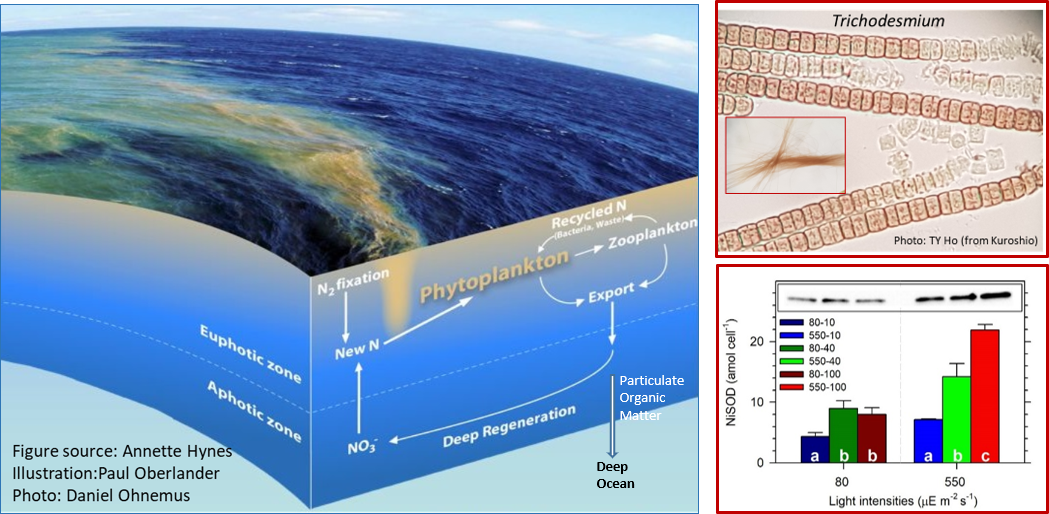


Figure: (Left) The brown material in the surface water is the bloom of Trichodesmium (hereafter Tricho). N2 fixation by diazotrophic cyanobacteria transforms N2 to NH4+ that all phytoplankton can utilize and thus promote photosynthesis and CO2 sequestration from the atmosphere. Part of particulate organic material synthesized may be transported into the deep water (>1000 m) and would recycle there for a long time (500-1000 yr), which can be considered as carbon removal from the atmosphere. (Upper right) Tricho collected in the Kuroshio water. Tricho is a filamentous diazotroph, with the width to be around 6 μm. The filaments may further form colonies. (Lower right) This study validated that NiSOD protects N2 fixation in Tricho under high light conditions by using different light intensities and Ni concentrations (Chen et al. 2022).
The ocean absorbs about 30% of anthropogenic CO2 annually! The cycling of CO2 absorbed by the ocean (Blue carbon) is mainly regulated by two processes, physical pump (or solubility pump) and biological pump. Physical pump is regulated by temperature and the concentration differences of CO2 at the air-sea interface. You may imagine the processes using coke drink as an analogue, releasing CO2 under high temperature or supersaturation conditions and taking up CO2 under low temperature or undersaturation conditions (Henry’s law). The other process is called biological pump, which is through biological photosynthesis to take up CO2 and synthesize organic matter. Once particulate organic matter sinks into the deep water, the carbon would recycle in the deep water for a long time and may be considered as carbon removal from the atmosphere (Fig. left).
Unlike terrestrial plants, water is of course not a limiting factor for phytoplankton. Instead, the most limiting elements for phytoplankton are N, P, and Fe. In terms of nitrogen, the major bioavailable N sources are nitrate, nitrite, and ammonium (NO3-, NO2-, NH4+). All phytoplankton are unable to utilize N2, except diazotroph. Nitrogen fixation transforms N2 to new fixed nitrogen and promote the growth of phytoplankton and CO2 uptake. Thus, biological N2 fixation becomes a critical process influencing CO2 sequestration and cycling on Earth! What we know about the environmental factors regulating N2 fixation in the ocean is still limited. Previous studies indicate that the supply of Fe and P can be important but related evidences in the field are still limited.
N2 fixation is catalyzed by nitrogenase, an enzyme that is vulnerable to O2 and oxidative stress generated in photosynthesis. However, Trichodesmium, a major N2 fixation cyanobacterial group in the tropical and subtropical oceans, unusually carries out N2 fixation and photosynthesis together and possesses the capability to bloom in the surface water with high light. “In photosynthesis, solar radiation energy splits and oxidizes H2O into O2, electrons, and protons in photosystem II (PSII). High solar radiation thus accelerates electron generation via PSII and elevates the gross production rates of O2 and ROS. On the other hand, superoxide, a major ROS generated in photosystem I (PSI), serves as the primary intermediate in the photoreduction of O2 to transport electrons to the Mehler reaction or also known as Water-Water cycle. Originating from the reduction of two O2 molecules, the two superoxide molecules are spontaneously scavenged by SOD and disproportionately reduced and oxidized to one H2O2 and one O2. H2O2, another ROS intermediate, is oxidized to water by catalase to complete the electron transfer chain and reduce the ROS accumulation or oxidative stress (Asada 1999).”, quoted from Chen et al. (2022). How Tricho carry out N2 fixation and photosynthesis simultaneously under high light conditions is the major question of this study.
Our hypothesis is that the metal requirement for SOD synthesis would be elevated to reduce ROS stress when ROS production is elevated in photosystems under high light conditions. It is worth of noting that there is a unique SOD in Tricho, nickel SOD. Our previous studies found that Ni is essential for the growth of Tricho and can elevate its SOD activities and N2 fixation rates (Ho 2013). Sufficient Ni supply is essential for Tricho to have high N2 fixation rates under high light conditions (Ho et al. 2013; Rodriguez and Ho 2014). In this study, we custom-designed NiSOD antibody and validated and quantified its concentrations by producing and purifying the recombinant NiSOD protein through E. coli (Chen et al. 2022). Our study demonstrated that NiSOD reduces ROS stress generated during photosynthesis and thus protects its N2 fixation process under high light conditions. The findings of the study may explain why Tricho can carry out N2 fixation and photosynthesis simultaneously and survive and bloom in the surface water of the tropical ocean. The results may also shed light on the mechanisms of photoinhibition for phytoplankton under high solar radiation conditions.
The first author of this study, Chih-Chang Chen, brilliantly and successfully carried out the key experiments. Chih-Chang was a research assistant in our lab and currently is a graduate student of Utrecht University, Netherland. It is the first Taiwanese paper published in Limnology and Oceanography Letters (JCR 2021, Oceanography JCI=1/68).
Key points
More information